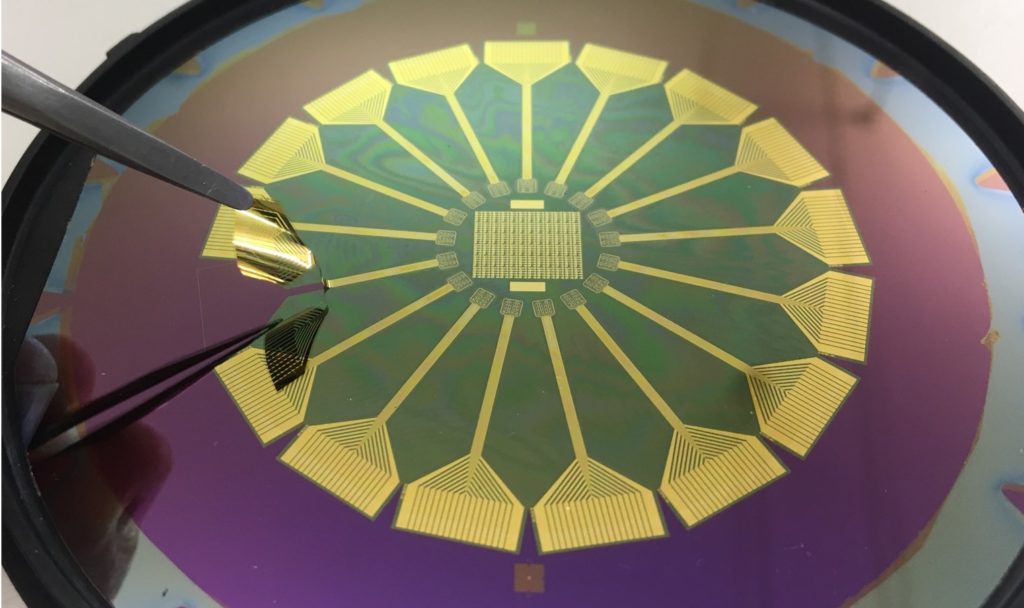Graphene, AI and the brain: an extraordinary journey into human consciousness
Collaborations National Graphene Institute Research 24 June 2022
A world-leading Manchester nanoscientist says we are about to embark on a fantastic journey into the brain – and predicts a breakthrough “decoder” that could help us better understand human pathology, perception, capacity and consciousness.
Kostas Kostarelos, Professor of Nanomedicine at The University of Manchester, says a combination of divergent technologies, including advanced materials like graphene, plus AI and advanced computing, are providing new and powerful tools for exploration of the cerebral space and function. With such technology only now, and for the first time, will neuroscientists be able to observe brainwaves at the lowest end of the spectrum (infraslow) with the greatest precision ever achieved by using ultra-sensitive graphene-enhanced sensors.
Graphene-enhanced sensors
Infraslow brainwaves are believed to be part of basic cortical rhythms, i.e. the inherent rhythmic electrical oscillations taking place in the brain – and these underline our higher brain functions. Very little is known about infraslow brainwaves because it is difficult to detect them accurately with current electrophysiological equipment. However, they appear to play an important role in brain timing and network function (1).
Previously MRI (magnetic resonance imaging) techniques have been applied to observe these mysterious brain patterns by recording changes in blood flow and extrapolating from these signals slow neuronal rhythms – but these frequencies can now be directly recorded with much greater accuracy and depth thanks to a new generation of probes using graphene.

These graphene-enhanced sensors are set to make exciting neuroscientific breakthroughs thanks to the flexibility of this 2D material. Graphene boasts unique electronic properties, and is highly stable and biocompatible.
“This is incredibly exciting for the neuroscience community. It opens up a whole new frontier for us,” said Kostas, who added: “An important application will be to better understand and help cure the various pathologies that affect the brain, such as epilepsy.
“Already my colleagues guided by Dr Rob Wykes, NanoNeuro Team leader at The University of Manchester Nanomedicine Lab, have been working with researchers based in the UK and Europe to discover how new graphene-based neural probes will improve detection of epileptic brain signals.”
A deeper dive into the brain
This award-winning graphene depth neural probe (gDNP) consists of a millimetre-long linear array of micro-transistors imbedded in a micrometre-thin polymeric flexible substrate. The transistors were developed in a collaboration between the nanomedicine Lab and UCL Institute of Neurology, along with their European Graphene Flagship partners the Catalan Institute of Nanoscience and Nanotechnology (ICN2) among others.
A study published in Nature Nanotechnology reveals that these unique flexible brain probes can be used to record pathological brain signals associated with epilepsy with excellent fidelity and high spatial resolution.
Kostas also said that the sophisticated graphene brain sensors could help us to better investigate other brain disorders. “Previously we couldn’t properly record spreading depolarisation, nor map how it propagates across the brain – the electrophysiological phenomenon associated with painful migraine headaches – because this occurs too low in the brain’s bandwidth for current electrodes to faithfully detect. But now we can look to better observe this phenomenon.”

Kostas added: “If this wasn’t exciting enough, I believe we can also use our graphene-enhanced probes to go beyond pathology and to discover much, much more about the workings of the brain that have been invisible up until now.
“We can look to dive deeper than ever before into uncharted parts of our brain to better understand what enables our cognitive experiences.”
Aware that his own teams could open up a new chapter in neuroscience – partly thanks to new technologies supported by advanced materials like graphene – Kostas is very keen to take inspiration from experts in other fields, especially those associated with AI and advanced computing.
The AI angle
“As we gradually gain much better access and recording capabilities of signals being emitted at the lower brain frequencies, we have the challenge of making sense of this plethora of new data – and AI will be essential in our ability to interpret this information.”
AI analytics, believes Kostas, will provide the necessary tools and techniques to discover insights, identify patterns and discover relationships in this new neurological data – and in collaboration with neuroscientists, electrophysiologists and neurologists unlock some of the complex, perhaps ‘mysterious’, processes involved in our higher functions.

Kostas is also looking to other pioneers who are using data and digital expertise to explore the workings of the brain. For example, the work of Manchester colleague Professor Steve Furber, ICL Professor of Computer Engineering and a senior research leader with the €1 billion Human Brain Project.
The Human Brain Project is a major European experiment to build ICT-based research infrastructure to help scientists work together across the fields of neuroscience, computing and brain-related medicine.
Professor Furber’s contribution to this programme has led to the development of a machine called SpiNNaker (short for Spiking Neural Network architecture). SpiNNaker is based on a computing platform made up of a million Advanced RISC Machine (ARM) microprocessors.
SpiNNaker supports computer models of systems that work in ways that are similar to the brain, enabling researchers to simulate areas of the brain and to test new hypotheses about how the brain might work.
The project was initially funded by the EPSRC and is now supported by the European Human Brain Project.
Kostas described the work of Manchester’s neuroscience teams as a “top down” approach to understanding brain function – essentially diving ever deeper into human brain – while the SpiNNAker team is taking a “bottom up” pathway, i.e. attempting to emulate brain functions by building large-scale models of a brain.
Where these two approaches will eventually meet, Kostas foresees an AI-type “decoder” that can help make sense of this convergence of knowledge and information around brain function – and this will eventually open a new door to understanding the fundamentals of the human experience.
2D MaterialsAdvanced materialsAIBraingrapheneManchestersensorsThe University of Manchester




